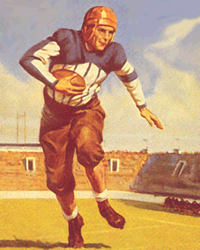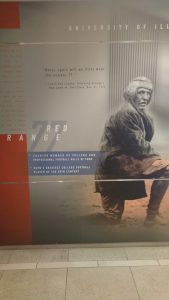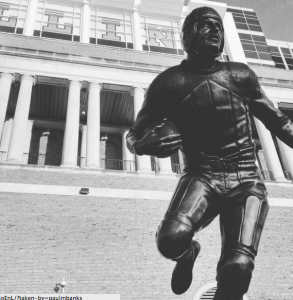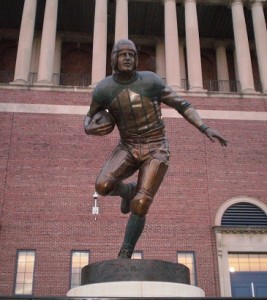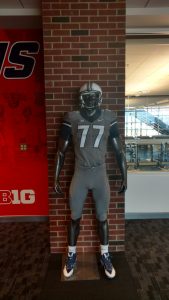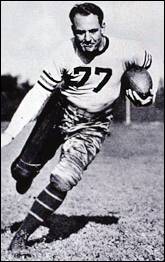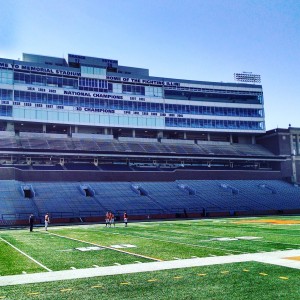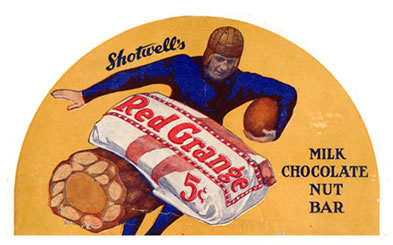Saturday brings No. 23 Illinois (5-1, 2-1 Big Ten) hosting No. 24 Michigan (4-2, 2-1 Big Ten) at what will be a sold out Memorial Stadium. It will mark the Illini’s Rededication Game, or 100th anniversary of the Red Grange game, which will kickoff at 2:30 p.m. CT on CBS.
So with that in mind, we re-publish this Red Grange piece from 2011.
Symposium: “Ghost Stories at Memorial Stadium” – Red Grange & the Game of the Century
Memorial Stadium 77 Club // LIVE STREAM
Thursday, Oct. 17 at 6:30 p.m. CT
The University of Illinois’ department of recreation, sport, and tourism will host a symposium on Red Grange and his impact to football and Illinois on Thursday, Oct. 17 leading up to the 100th Anniversary of his legendary performance against Michigan. The event will take place in the 77 Club, which dons Grange’s famous #77, inside of Memorial Stadium.Chris Willis, author of “Red Grange – the Galloping Ghost” (2019), will join the event as a special guest. Willis is one of the top football historians in the nation and the head archivist and producer at NFL Films.
The event is free and open to the public.
Just announced, the #1 overall sports icon in Big Ten history is…..Red Grange of the Illinois Fighting Illini!
He was the Babe Ruth of both college football and the NFL. He even had a candy bar named after him; just like Ruth.
Grange was named the greatest college football player of all-time by ESPN on New Year’s Day 2008, and he pretty much first put the Chicago Bears on the map back in the 1920s.
He was so big that required two nicknames, the “Galloping Ghost” which conveyed his immortality. And the “Wheaton Iceman” conveying the everyman qualities of this 5’10,” 175 pound legend.
He’s a charter member of its hall of fame and his sensational career vaulted the sport into the national consciousness for the first time. Now, Illinois’ Red Grange, the “Galloping Ghost,” has been named the No. 1 Big Ten Icon by the Big Ten Network.
Harold Grange grew up in Wheaton, Illinois and earned his nickname because of his red hair color. Despite his blazing speed and tremendous productivity, Grange was unsure whether he was big enough to play football at the collegiate level. He enrolled at Illinois in 1922, intending to play basketball and to run track.
According to legend, Grange was talked into joining the Illini football team by his Zeta Psi fraternity brothers. He made an immediate impact as a sophomore, scoring three touchdowns in his debut against Nebraska.
That season, Grange averaged 5.6 yards per carry, scored 12 touchdowns and helped the Illini win the 1923 national championship, with a perfect 7-0 record.
It wasn’t until his junior season, however, that Grange’s legend began.
In the first game at Illinois’ newly constructed Memorial Stadium, the Illini hosted Michigan, then owners of a 20-game winning streak.
Grange returned the opening kickoff 95 yards for a touchdown, and rushed for touchdowns of 67, 56 and 44 yards, all in the first quarter. He later scored two more touchdowns in the Illini’s 39-14 victory.
Grange’s first-quarter, four-touchdown performance made the national newsreels.
The Chicago Tribune called Grange’s effort “the greatest performance ever seen on an American gridiron.”
Legendary sportswriter Grantland Rice wrote:
“A streak of fire, a breath of flame. Eluding all who reach and clutch, a gray ghost thrown into the game; That rival hands may never touch; A rubber bounding, blasting soul; Whose destination is the goal – Red Grange of Illinois!”
With that, the legend of Red Grange was born. He became a three-time All-American and on October 5, 1925, at the age of 21, Grange appeared on the cover of Time magazine.
In 1969, in conjunction with college football’s 100th anniversary, the Football Writers Association of America named Grange to its all-time All-American team, its only unanimous selection.
The University of Illinois retired Grange’s No. 77 jersey in 1925. A 12-foot statue of Red Grange stands outside Memorial Stadium.
Paul M. Banks is the Founding Editor of The Sports Bank. He’s also the author of “Transatlantic Passage: How the English Premier League Redefined Soccer in America,” and “No, I Can’t Get You Free Tickets: Lessons Learned From a Life in the Sports Media Industry.”
He currently contributes to USA Today’s NFL Wires Network. His past bylines include the New York Daily News, Sports Illustrated and the Chicago Tribune. His work has been featured in numerous outlets, including the Wall Street Journal, Forbes, the Washington Post and ESPN. You can follow him on Linked In and Twitter.
